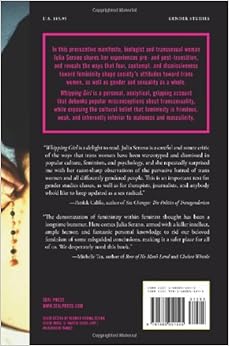
 A trans woman/femm e may be more likely to experience violence than a trans man/masc. This devalues womanhood, by defining its purpose as sexual (misogyny). This questions her process and reasoning in transitioning (transphobia). A media representation of a trans woman may be overtly sexual, or portray her desire to transition as sexual. This does not respect the trans woman’s gender identity (transphobia) and portrays femininity as undesirable (misogyny). In a movie, jokes may be made to disparage a trans woman’s desire to be feminine. They may misgender or deadname her (transphobia), as well as comment negatively on her feminine clothing or makeup (misogyny). A trans woman wearing a dress or make up may be ridiculed on the street by an onlooker. The following is a non-comprehensive list: Transmisogyny can manifest in a variety of ways. By understanding this intersection, people can better understand the origins and the effects of transmisogyny. Thus, someone who holds both the identity of trans and womanhood/femininity is affected by these oppressions simultaneously. While transphobia and misogyny impact many people’s lives, these oppressions compound and join together. By coining transmisogyny, Serano recognizes intersectionality. Serano proposes that transmisogyny is based on the assumption that femininity is worth less than masculinity, and that femaleness exists in the service of maleness (Serano 2017). Transmisogyny was coined by Julia Serano, author of Whipping Girl and trans activist ( Sojka 2017 ). Thus, transmisogyny works to portray trans women and transfeminine people as less than, questions and devalues their gender identity, and sexualizes their femininity ( Sojka 2017 ). However, it also affects trans and nonbinary folks who may be perceived as feminine (Kacere 2018). Transmisogyny primarily affects trans women and transfeminine people ( Sojka 2017 ).
A trans woman/femm e may be more likely to experience violence than a trans man/masc. This devalues womanhood, by defining its purpose as sexual (misogyny). This questions her process and reasoning in transitioning (transphobia). A media representation of a trans woman may be overtly sexual, or portray her desire to transition as sexual. This does not respect the trans woman’s gender identity (transphobia) and portrays femininity as undesirable (misogyny). In a movie, jokes may be made to disparage a trans woman’s desire to be feminine. They may misgender or deadname her (transphobia), as well as comment negatively on her feminine clothing or makeup (misogyny). A trans woman wearing a dress or make up may be ridiculed on the street by an onlooker. The following is a non-comprehensive list: Transmisogyny can manifest in a variety of ways. By understanding this intersection, people can better understand the origins and the effects of transmisogyny. Thus, someone who holds both the identity of trans and womanhood/femininity is affected by these oppressions simultaneously. While transphobia and misogyny impact many people’s lives, these oppressions compound and join together. By coining transmisogyny, Serano recognizes intersectionality. Serano proposes that transmisogyny is based on the assumption that femininity is worth less than masculinity, and that femaleness exists in the service of maleness (Serano 2017). Transmisogyny was coined by Julia Serano, author of Whipping Girl and trans activist ( Sojka 2017 ). Thus, transmisogyny works to portray trans women and transfeminine people as less than, questions and devalues their gender identity, and sexualizes their femininity ( Sojka 2017 ). However, it also affects trans and nonbinary folks who may be perceived as feminine (Kacere 2018). Transmisogyny primarily affects trans women and transfeminine people ( Sojka 2017 ). 
Misogyny is the hatred and devaluation of women and of femininity (Kacere 2018).

Transphobia is the discrimination and oppression of trans people for their gender expression. Transmisogyny describes the intersecting oppressions and discriminations of transphobia and misogyny ( Sojka 2017 ).







 0 kommentar(er)
0 kommentar(er)
